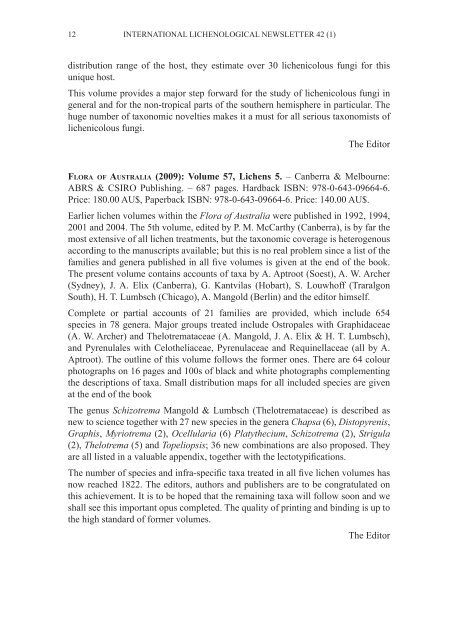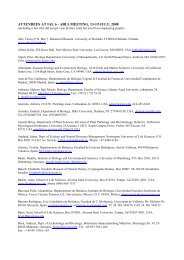international lichenological - International Association for Lichenology
international lichenological - International Association for Lichenology
international lichenological - International Association for Lichenology
Create successful ePaper yourself
Turn your PDF publications into a flip-book with our unique Google optimized e-Paper software.
12 INTERNATIONAL LICHENOLOGICAL NEWSLETTER 42 (1)<br />
distribution range of the host, they estimate over 30 lichenicolous fungi <strong>for</strong> this<br />
unique host.<br />
This volume provides a major step <strong>for</strong>ward <strong>for</strong> the study of lichenicolous fungi in<br />
general and <strong>for</strong> the non-tropical parts of the southern hemisphere in particular. The<br />
huge number of taxonomic novelties makes it a must <strong>for</strong> all serious taxonomists of<br />
lichenicolous fungi.<br />
The Editor<br />
FLORA OF AUSTRALIA (2009): Volume 57, Lichens 5. – Canberra & Melbourne:<br />
ABRS & CSIRO Publishing. – 687 pages. Hardback ISBN: 978-0-643-09664-6.<br />
Price: 180.00 AU$, Paperback ISBN: 978-0-643-09664-6. Price: 140.00 AU$.<br />
Earlier lichen volumes within the Flora of Australia were published in 1992, 1994,<br />
2001 and 2004. The 5th volume, edited by P. M. McCarthy (Canberra), is by far the<br />
most extensive of all lichen treatments, but the taxonomic coverage is heterogenous<br />
according to the manuscripts available; but this is no real problem since a list of the<br />
����������������������������������������������������������������������������������<br />
The present volume contains accounts of taxa by A. Aptroot (Soest), A. W. Archer<br />
(Sydney), J. A. Elix (Canberra), G. Kantvilas (Hobart), S. Louwhoff (Traralgon<br />
South), H. T. Lumbsch (Chicago), A. Mangold (Berlin) and the editor himself.<br />
Complete or partial accounts of 21 families are provided, which include 654<br />
species in 78 genera. Major groups treated include Ostropales with Graphidaceae<br />
(A. W. Archer) and Thelotremataceae (A. Mangold, J. A. Elix & H. T. Lumbsch),<br />
and Pyrenulales with Celotheliaceae, Pyrenulaceae and Requinellaceae (all by A.<br />
Aptroot). The outline of this volume follows the <strong>for</strong>mer ones. There are 64 colour<br />
photographs on 16 pages and 100s of black and white photographs complementing<br />
the descriptions of taxa. Small distribution maps <strong>for</strong> all included species are given<br />
at the end of the book<br />
The genus Schizotrema Mangold & Lumbsch (Thelotremataceae) is described as<br />
new to science together with 27 new species in the genera Chapsa (6), Distopyrenis,<br />
Graphis, Myriotrema (2), Ocellularia (6) Platythecium, Schizotrema (2), Strigula<br />
(2), Thelotrema (5) and Topeliopsis; 36 new combinations are also proposed. They<br />
����������������������������������������������������������������������������<br />
�����������������������������������������������������������������������������������<br />
now reached 1822. The editors, authors and publishers are to be congratulated on<br />
this achievement. It is to be hoped that the remaining taxa will follow soon and we<br />
shall see this important opus completed. The quality of printing and binding is up to<br />
the high standard of <strong>for</strong>mer volumes.<br />
The Editor






